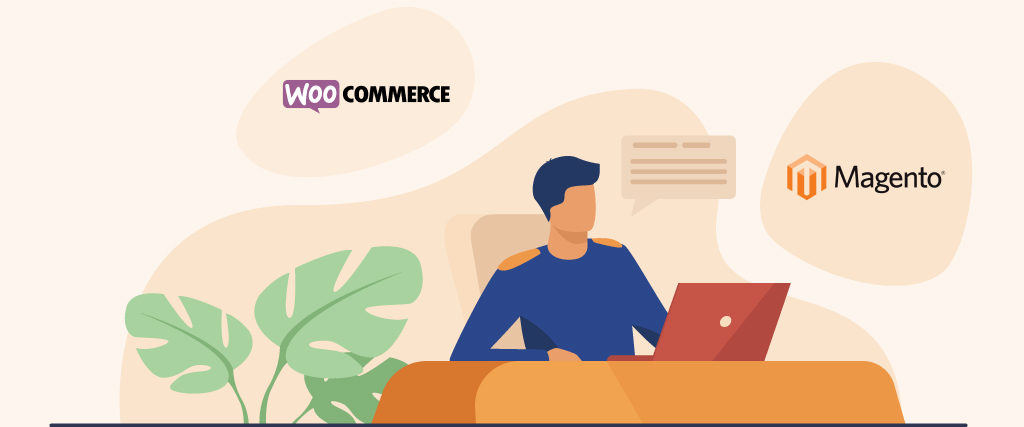WooCommerce vs Magento: The success of any eCommerce business solely depends on the platform behind it. If you’re already running an e-store or planning to start one, at some point in time you might have been ambivalent between the pool of options out there.
The industry is full of myriad solutions, from a smaller seller to a big vendor everyone can find something right that fits their requirements. Choosing the right platform and successfully implementing it to run your e-store, can be a progressive move.
Though selecting a suitable platform for an online store has never been a cake walk for a merchant. If you are looking for a self-hosted e-commerce system that lets you take over the control and manage your store, WooCommerce vs Magento are the top sites on the list.
What to look for in your eCommerce Platform?
If you’re a newbie into this, then you might need to know about a few things when it comes to choosing the right platform. One should consider the below points to find the best e-commerce solution.
- Budget- You should look at platforms that come under your range.
- Ease of use- Always go for platforms that are beginner-friendly.
- Payment Methods- The platform should support various payment options.
- Scalability- Your e-Commerce platform should be able to scale with the emerging technologies to run your business successfully.
However, you might wonder, which platform is more appropriate for your e-store? Just a glance over the below article might solve your problem and in the end, you might shortlist ‘the one’ platform for your store.
WooCommerce vs Magento – Let’s peep a bit more into Woocommerce
WooCommerce is a free WordPress plugin that was first launched in 2011. Today, after a decade it is one of the most popular e-commerce platforms in the world.
Prime features like extendability, flexibility, simplicity, and open-sourced platforms allow the end-users to build the store they need and define their own brand style.
According to the sources, more than 30% of the online stores run on the WooCommerce platform. After all, it allows businesses to sell products either digital or physical items through direct-from-business or drop-shipping methods.
For starters, WooCommerce works on a broad, basic level. Since it’s an open-source WordPress plugin, it acts as a third-party integration instead of signing up for a single hosting-to-checkout platform.
As of now, the standard plugin is absolutely free to use, while for additional functions and more flexibility, users can install plugins and other extensions, most of them come at an affordable rate. With the emerging trends, plugins usually become a necessity in order to enhance the user experience.
WooCommerce is the most popular free solution for e-store merchants. Websites like Porter & York, EcoKitty, Apogee CE, and Yousli were created based on this plugin. Overall, the plugin is used on over 10,000 sites, though it isn’t the most trafficked, but surprisingly, every tenth online store is made on WooCommerce.
Listed below are some of the good things and a few not-so-good things about this popular platform.
Pros
- It is a plugin for WordPress
- Standard ownership is available at a reasonable cost
- Easy to get the hang of it
- Usually works well with content zeroed sites that can make use of WordPress CMS capabilities
- Uncountable themes to go with your sites
- Its functionality is best for e-stores selling eBooks, podcasts, etc.
- Many plugins are available, most of them are unpaid.
- Cheaper to host when compared to others.
- It has the largest community support.
- Stores a gazillion of tutorials
Cons
- It often requires many additional plugins to achieve the ideal functionality of the site that can lead to a fair of number issues.
- There is only one version of WooCommerce.
- Scalability can be a fuss for larger sites.
- As WooCommerce is a WordPress plugin, one needs to have extreme knowledge of the WordPress platform to leverage everything that WooCommerce has to offer.
A little more about Magento
Magento is an open-source e-commerce platform that allows businesses to build online stores, easy transactions, and manage products.
It has got two versions, one is free, while the other one is a paid solution that comes with more features, cloud hosting, and great support. The platform can be extended using different extensions and a nice set of templates to make your site more appealing to look at.
Magento is a highly popular e-commerce platform that comes in both Community and Enterprise versions. It’s been a backbone for sites as Helly Hansen, Sigma Beauty, Ford, Vizio, Landrover, Nike, Nestle Nespresso, etc.
In figures, almost 170,000 online stores are powered by this platform. Their company’s slogan goes as, ‘Designed to grow, built for flexibility.
While there is no limit to the big players in e-business, Magento has been on the front line for ages. It’s due to the uncountable good things that the site has to offer.
However, it also comes with a handful of disadvantages. Here we have made a list of pros and cons for you to weigh in choosing this platform.
Pros
- It is flexible
- It has got thousands of features that other platforms lack
- Supported by a large community of daily users
- This platform is known for its incredible scalability
- It has got multiple editions like Open Source, Cloud, and others.
- Powered B2B eCommerce capabilities
- More advanced payments and shipping ways
- Multilingual and multi-currency availability
- Mobile-friendly
Cons
- One has to spend an arm and leg to get the full advantage of the useful features.
- It’s not beginner’s-friendly, one should have minimum knowledge on the technical field
- Weak CMS capabilities for more content sites
- Hosting is costly
A Final Showdown between WooCommerce vs Magento
Installation: WooCommerce can be installed on a 2GB server due to it being much lighter and simpler than Magento. While Magento requires much more memory space due to its unlimited resources and the integration of SSH to be launched on the system.
Features: Magento’s core business is to offer medium or large enterprises. Small businesses can try the free version, but this platform can be quite challenging to learn. And WooCommerce can be robust, flexible, scalable, popularly known for ease-of-use, and above all it’s beginner-friendly.
Security: When compared in the security spectrum, Magento provides stronger security for online stores with Magento Patches being released recently. It is the latest free tool that helps you monitor your site, update malware patches, and search for unauthorized access. Hence Magento completely wins over WooCommerce in terms of security.
Performance and Speed: Performance and speed are prominent factors that hold major points when it comes to choosing any platform. In case your site is annoyingly slow and sluggish, most of the visitors will swiftly back out instead of exploring your e-store.
And this results in a huge loss of your business. Additionally, the number of modules, extensions might also affect your site’s speed and functionality. Therefore, it totally depends on your preferences and choices.
Extensions and Plugins: When we look into plugins and extensions, every platform provides a wide range of them. WooCommerce allows owners to easily launch a wide set of add-ons to customize their website.
They come at a cheaper price when compared to Magento. However, Magento’s plugins are more powerful and its e-stores would draw more points in this field.
Above, is a brief recap of the plus and minus points of the two popular platforms. We know that every platform comes with its own strengths and weaknesses. More to this, it totally depends on the store’s needs.
Conclusion
Magento and WooCommerce, both platforms are popularly used to build any kind of online store. However, it comes down to your budget and the right requirements for your store. It’s also important to take a deep dive into the features you need now and choose the platform with a promising future.
WooCommerce already has a brownie point as it runs on the world’s most popular website builder that is WordPress. And the fact that this tool is absolutely free of charge makes it all the more interesting for the users who have managed to get the hang of basic WordPress.
The blend of both sites would make your business flourish like never before. It’s also user-friendly and one can easily afford to run their business successfully with the right features.
Magento is designed to be a robust e-commerce platform from the ground level. It is the least easy-to-use e-commerce site, you got skills, Magento can be your platform.
However, when it comes to leveraging the various features, plug-ins, the costs might skyrocket, and not forget the technical challenges one might come across.
If you can afford the growing costs, alongside the scalable features, then the easier option for you, would be switching to Magento. In no time your business would prosper beating the rest.
We hope this article helped you to distinguish the pros and cons between WooCommerce vs Magento. One can choose the right platform depending on their store’s requirements.
Read More: FEW KEY ELEMENTS THAT CAN’T BE IGNORED ABOUT MAGENTO – THE LEADING ECOMMERCE STORE
























